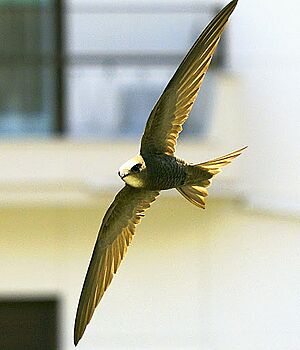Pallid swift facts for kids
Quick facts for kids Pallid swift |
|
|---|---|
 |
|
| Flying in Greece | |
| Conservation status | |
| Scientific classification |
The pallid swift (Apus pallidus) is a fascinating bird. It belongs to a group of birds called swifts. Swifts are known for spending almost their entire lives flying! They have tiny legs. These legs are only used for clinging to walls or cliffs. They never land on the ground.
The name Apus comes from Latin. It means "without feet." Ancient people thought swifts were like swallows but had no feet. Pallidus is also Latin. It means "pale," describing the bird's color. Pallid swifts catch insects in the air to eat. They even drink while flying!
Contents
Discovering the Pallid Swift
The pallid swift was first officially described in 1870. An English expert on nature, George Ernest Shelley, gave it its scientific name.
What Does a Pallid Swift Look Like?
This bird is about 16 to 17 centimeters (6 to 7 inches) long. It looks very much like the common swift. It can be hard to tell them apart without a good view. Like its relatives, it has a short, forked tail. Its wings are very long and swept back. They look a bit like a crescent moon or a boomerang.
The pallid swift is mostly dark brown. It has a large white patch on its throat. This patch is often easy to see from far away. It is a bit chunkier and browner than the common swift. Its flight feathers, belly, and rump are slightly paler. This gives it more contrast than the common swift. Its belly also looks a bit scaly. Its flight style is slightly different too. The pallid swift makes a loud, dry screaming sound. It is similar to the common swift's call.
Where Do Pallid Swifts Live?
Pallid swifts breed on cliffs and under the eaves of buildings. They are found around the Mediterranean Sea. They also live on the Canary Islands and Madeira. Female swifts usually lay two eggs.
These birds are rare north of their usual breeding areas. It can be hard to spot them because they look so much like common swifts. Pallid swifts arrive earlier and leave later than common swifts. This is because they live in warmer southern areas. So, if you see a swift very early or late in the year, it might be a pallid swift!
Amazing Migrations
Like swallows, pallid swifts are migratory birds. This means they travel long distances. They spend their winters in southern Africa or southeast Asia.
Scientists have used GPS technology to track pallid swifts. They followed birds that breed in Gibraltar. This tracking showed that these swifts have several winter homes in Africa. These homes are south of the Sahara Desert. One bird was tracked for two winters in a row. It returned to the exact same places in Africa each year. The study also showed that swifts truly live in the air. Two pallid swifts did not land at all during their non-breeding season!



